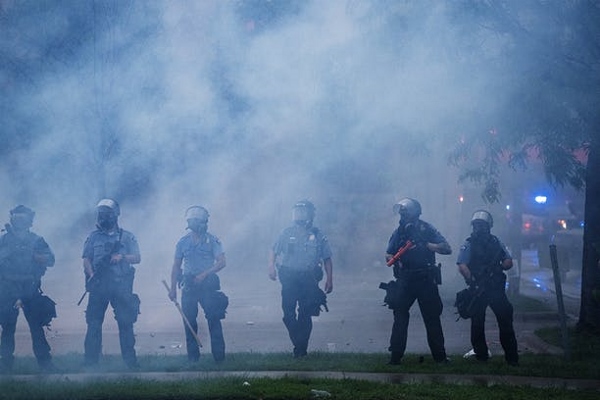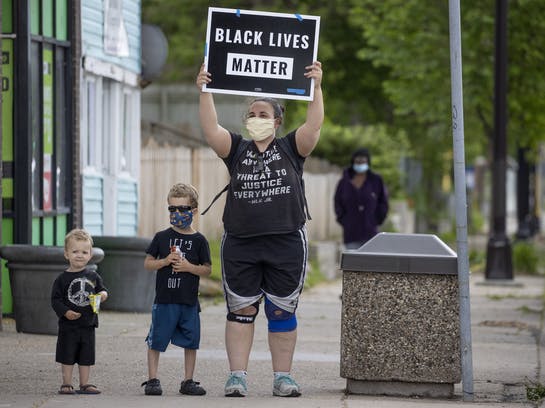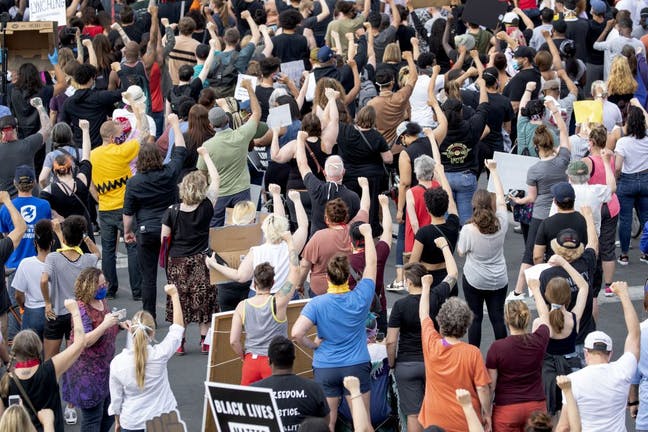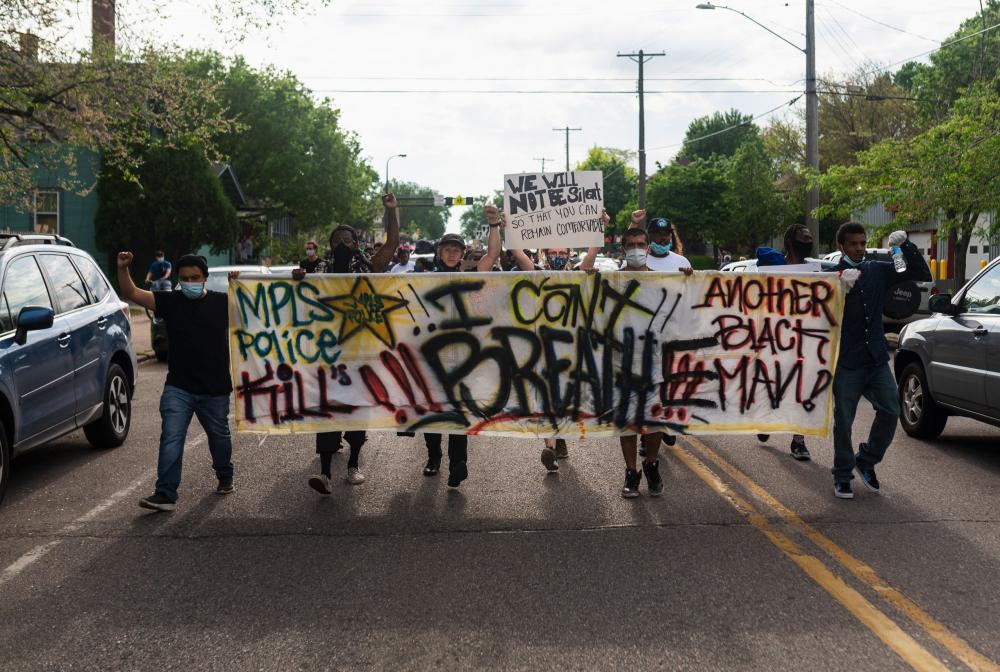Minneapolis Council Member: 'Police in the City Failed Us' in Protest Response; The Death of George Floyd, in Context
Minneapolis Council Member: 'Police in the City Failed Us' in Protest Response - Andy Mannix and Miguel Otárola (Minneapolis Star Tribune)
The Death of George Floyd, in Context - Jelani Cobb (The New Yorker)
Background: Police Problems in Minneapolis Not New - Editorial counterpoint: We must look beyond police for community safety - Tony Williams, Leilah Abdennabi and Sheila Nezhad (Minneapolis Star Tribune)
City Council Member Jeremiah Ellison is among those condemning the police response to protests over the killing of George Floyd.
By Andy Mannix and Miguel Otárola
May 28, 2020
Minneapolis Star Tribune
Jeremiah Ellison was passing out water bottles to protesters near the Minneapolis Police Third Precinct on Tuesday night when a teenage girl emerged from the crowd, bleeding from the head, and stumbled toward him.
Ellison, a Minneapolis City Council member, happened to be holding a towel he’d pulled from his pocket a moment earlier. He helped her sit down and wipe the blood from her face.
“I’m just holding this bloody towel like, ‘This is out of control. This is completely out of control,’ ” Ellison said Wednesday, describing the encounter.
“The police in the city failed us last night,” he said.

Richard Tsong-Taatarii - Minneapolis Star Tribune
Ellison was among those condemning the Minneapolis Police Department’s response to well over a thousand people who broke state-ordered limitations on public gatherings Tuesday night to protest the killing of George Floyd, an unarmed black man who died shortly after being restrained by officers from the Third Precinct.
Video of the incident shows an officer identified as Derek Chauvin pinning Floyd on the street while Floyd pleads repeatedly that he can’t breathe, and as bystanders ask the officers to stop.
Mayor Jacob Frey on midday Wednesday commended the “99 percent” of peaceful protesters and empathized with their desire to protest. But he said Chief Medaria Arradondo deployed the officers to stop protesters after some broke windows at the precinct building and in squad cars, both of which had live ammunition and guns inside.
“He told me that he could not run the risk of one tragedy leading to another,” Frey said. “Our chief made the decision and I support our chief. I trust his judgment.”
Tuesday’s protest started peacefully around 5 p.m., as mask-wearing crowds gathered outside Cup Foods in south Minneapolis, the same spot where the officers had detained Floyd less than 24 hours earlier.

Elizabeth Flores - Minneapolis Star Tribune

Carlos Gonzalez - Minneapolis Star Tribune
As the protest marched to the Third Precinct, several demonstrators smashed windows and hurled objects at the precinct building. They then vandalized squad cars parked outside.
Officers in riot gear responded with force, flooding Lake Street with tear gas and flash-bangs and shooting fluorescent marking rounds and other less-lethal projectiles indiscriminately into the crowd.
A similar scene played out there late Wednesday. Protesters tossed bottles and rocks at officers, who again responded with projectiles, tear gas and flash bombs.
Also Wednesday night, looting broke out at the Lake Street Target store, where intruders carted off large TVs, clothing and food, and at nearby Minnehaha Lake Wine & Spirits.
Late Wednesday, protesters set fire to the AutoZone across the street from Third Precinct headquarters. While some protesters tried to put the fire out, others gleefully posed for selfies in front of the flames.
Calls for change
Ellison, who ran for office after participating in demonstrations following the 2015 police shooting of Jamar Clark, said he felt helpless to stop what he described on Twitter as Tuesday’s “disgusting display” by police.
“The police always respond this way to crowds, and things always get out of hand,” he said. “And I don’t know how the strategy doesn’t change. And I’ll tell you right now I’ve made calls requesting that the strategy change, and it still has not.”

Glen Stubbe, Minneapolis Star Tribune
Ellison witnessed some protesters throwing objects at police. But he said the police response didn’t match the protesters’ actions, and the people he saw getting hurt were all peaceful.
“I feel like the police, and we as elected officials who manage the police, had a responsibility to respond more compassionately and more intelligently,” he said. “And we didn’t do that last night.”
Other council members also criticized police actions Tuesday.
Council Member Andrea Jenkins, who represents the area where Floyd was arrested, said the protest outside Cup Foods was “one of the most peaceful rallies I have been to.” She said she had begged Arradondo and Frey to not have officers use force on protesters.
“I’m disappointed, I’m distressed, I’m disturbed by the use of force last night,” she said.
Council Member Andrew Johnson, who represents much of the area covered by protesters Tuesday, said he wanted answers as to why police officers used chemicals and projectiles.
“What I saw from some of the scenes last night looked to be disproportionate and escalating force,” he said. “It’s extremely concerning, and we need answers and accountability for that.”
At a news conference Wednesday, Arradondo said that while most protesters were peaceful, others had “disregarded the notion of respecting … space and personal safety.”
“There was some property damage and destruction that occurred, some that was quite significant,” he said. “I directed our folks to keep a level of restraint so we did not respond when that occurred. I did direct our officers to deploy gas once a secure fence was breached and those individuals — again, not all — some of those individuals were in our secured parking facility, which had access to our Minneapolis squad cars and weapons, quite frankly.”
On Wednesday afternoon, V.J. Smith, the president of the Minneapolis chapter of MAD DADS, an anti-violence program, spoke to a peaceful crowd gathered near Cup Foods about the need to protest without destroying surrounding businesses and homes. He said he was upset about the damage caused by protesters Tuesday night, including broken windows and spray paint on businesses and churches.
“You give violence, you get it back. You’re going to get it back,” he said. “We have to understand there is a certain way to protest.”
Staff writers Libor Jany, Liz Navratil and Paul Walsh contributed to this report.
[Andy Mannix covers federal courts and law enforcement for the Star Tribune. He joined the paper in January 2016 and previously covered Minneapolis City Hall and statewide criminal justice/Department of Corrections.
Miguel Otárola is a reporter covering Minneapolis City Hall for the Star Tribune. He previously covered Minneapolis' western suburbs and breaking news. He also writes about immigration and music on occasion.]
The Death of George Floyd, in Context
By Jelani Cobb
May 28, 2020
The New Yorker

Photograph by Stephen Maturen / Getty // The New Yorker
Two incidents separated by twelve hours and twelve hundred miles have taken on the appearance of the control and the variable in a grotesque experiment about race in America. On Monday morning, in New York City’s Central Park, a white woman named Amy Cooper called 911 and told the dispatcher that an African-American man was threatening her. The man she was talking about, Christian Cooper, who is no relation, filmed the call on his phone. They were in the Ramble, a part of the park favored by bird-watchers, including Christian Cooper, and he had simply requested that she leash her dog—something that is required in the area. In the video, before making the call, Ms. Cooper warns Mr. Cooper that she is “going to tell them there’s an African-American man threatening my life.” Her needless inclusion of the race of the man she fears serves only to summon the ancient impulse to protect white womanhood from the threats posed by black men. For anyone with a long enough memory or a recent enough viewing of the series “When They See Us,” the locale of this altercation becomes part of the story: we know what happened to five young black and brown men who were falsely accused of attacking a white woman in Central Park.
On Monday evening, in Minneapolis, Minnesota, a forty-six-year-old black man named George Floyd died in a way that highlighted the implications that calls such as the one Amy Cooper placed can have; George Floyd is who Christian Cooper might have been. (The police made no arrests and filed no summons in Central Park. Amy Cooper has apologized for her actions; she was also fired from her job.) Police responding to a call from a shopkeeper, about someone trying to pass a potentially counterfeit bill, arrested Floyd. Surveillance video shows a compliant man being led away in handcuffs. But cellphone video later shows a white police officer kneeling on Floyd’s neck for seven minutes, despite protests from onlookers that his life is in jeopardy. In an echo of the police killing of Eric Garner, in 2014, Floyd repeatedly says, “I can’t breathe,” and then, “I’m about to die.” When the officer eventually removes his knee, Floyd’s body is limp and unresponsive. A person nearby can be heard saying, “They just killed him.” Floyd was taken to a hospital, where he was pronounced dead. A police statement said that Floyd appeared to be in “medical distress,” but made no mention of his being pinned to the ground with the weight of a police officer compressing his airway.
The video of Floyd’s death is horrific but not surprising; terrible but not unusual, depicting a kind of incident that is periodically reënacted in the United States. It’s both necessary and, at this point, pedestrian to observe that policing in this country is mediated by race. On Tuesday, in Minneapolis, hundreds of protesters, many wearing face masks to guard against covid-19, braved the pandemic to protest at the spot where Floyd died. Outside a nearby precinct house, police cars were pelted with rocks, and officers responded by firing tear gas. But, within twenty-four hours of the video coming to light, the Minneapolis Police Department fired the officer who had knelt on Floyd and three others who had been at the scene. Mayor Jacob Frey tweeted that the firings were “the right call,” but here, too, context matters.
In November, 2015, police responding to calls of a dispute between a man and a woman in north Minneapolis fatally shot a twenty-four-year-old African-American man named Jamar Clark. Police and paramedics on the scene claimed that Clark had resisted arrest and had attempted to grab an officer’s gun; bystanders claimed that he was handcuffed and on the ground when the shot was fired. Clark’s death was followed by more than two weeks of demonstrations outside the Fourth Police Precinct in Minneapolis, led by Black Lives Matter; an attempt to disrupt holiday shopping at the Mall of America, in protest; and cascading contempt from black residents that, two years later, factored into Mayor Betsy Hodges losing her reëlection bid. In light of that history, Frey has been unequivocal about police culpability in Floyd’s death. “Being black in America should not be a death sentence,” he said on Tuesday.
The larger question, however, is whether the officers involved will face any legal consequences. The Twin Cities area has been an outsized part of the dialogue about the police use of force. The year after Clark’s death, Philando Castile was fatally shot in Falcon Heights, Minnesota, by a police officer who was alarmed because Castile had a gun in his car, even though he had identified himself as a licensed gun owner. (Castile’s girlfriend recorded the aftermath of the shooting on her phone.) In 2017, Justine Damond was fatally shot by a police officer who was responding to her own call about a possible assault taking place behind her Minneapolis home. No charges were brought against officers in Clark’s death. Jeronimo Yanez, the officer who killed Castile, was fired from the department, but was acquitted of second-degree-manslaughter charges. Mohamed Noor, the officer who shot Damond, was convicted of third-degree murder and second-degree manslaughter, and was sentenced to twelve and a half years in prison. The Damond case was atypical, both in that it involved the fatal shooting of a white woman by a black officer of Somali descent, and that Damond was an Australian citizen, which generated international pressure for a conviction in the case. No charges were brought against Officer Daniel Pantaleo in the death of Eric Garner, on Staten Island, whose arrest was also recorded on video by a bystander, and has been widely referenced since Floyd’s death. (He was fired from the department in 2019.) By odd coincidence,“American Trial,” a film that features a mock trial of Pantaleo for murder, was just released.
The investigation into Floyd’s death also exists in the context of an ongoing investigation into the death of Ahmaud Arbery, a twenty-five-year-old African-American who was shot in southeast Georgia when two men attempted to enact a citizen’s arrest while a third recorded a video of the incident. There is yet another investigation of fatal police force in Louisville, Kentucky, where Breonna Taylor, a twenty-six-year-old African-American E.M.T., was shot to death in her apartment by officers who were conducting a drug raid at what her family said was the wrong address.
There is more to be said about the burgeoning genre of videos capturing the deaths of black Americans, and the complex combination of revulsion and compulsion that accompanies their viewing. They are the macabre documentary of current events, but the question remains about whether they do more to humanize or to objectify the unwilling figures at the center of their narratives. Death is too intimate a phenomenon to not be distorted by a mass audience. Yesterday, very few of us knew who George Floyd was, what he cared about, how he lived his life. Today, we know him no better save for the grim way in which that life met its end.
[Jelani Cobb is a staff writer at The New Yorker and the author of “The Substance of Hope: Barack Obama and the Paradox of Progress.”]
Background - Police Problems in Minneapolis Not New
Editorial counterpoint: We must look beyond police for community safety
It's time to put more emphasis on prevention efforts. A police-first approach isn't effective, has been marred by violence and fails to address underlying causes of crime.
By Tony Williams, Leilah Abdennabi and Sheila Nezhad
March 21, 2019
Minneapolis Star Tribune
As community leaders calling for less funding for police and more funding for alternative community safety measures, we were glad to see the Star Tribune Editorial Board reflecting on the relationship between police and public safety a few weeks ago (“Defunding cops is not the answer,” March. 8). Unfortunately, we disagree with many of the points raised.
In the spirit of robust public debate, we’d like to share more about why we have become convinced that to ensure the long-term safety of our communities, we must look beyond police.
The Minneapolis Police Department receives $189 million in funding from the city each year, supplementing that funding with other revenue sources. That’s more than our Health Department, Department of Civil Rights, and Community Planning and Economic Development combined ($159.8 million). How are those resources being spent?
In 2018 alone, the Minneapolis Police Department came under fire for killing Thurman Blevins and Travis Jordan. They pressured EMS personnel to drug community members with ketamine. They set up a series of stings to entrap poor black men for low-level marijuana sales, in a state that nears closer to legalization each day. And they utterly failed, as evidenced by a powerful series in the Star Tribune, to properly investigate dozens, if not hundreds, of sexual assault cases.
Minneapolis isn’t alone — racism, corruption and brutality are common in police departments across the country.
So why do we keep treating the police as if they are the one true path to community safety? It isn’t true, as the Editorial Board suggests, that police are the most cost-effective way to keep our communities safe. Decades of social science research has revealed that the biggest contributor to violent crime is poverty, while a 2016 meta analysis of hundreds of studies by Yongjei Lee, John Eck and Nicholas Corsaro found that the relationship between police force size and crime levels isn’t statistically significant.
As public health experts have been saying for centuries, an ounce of prevention is worth a pound of cure. A police-first approach to public safety fails to address the underlying causes of crime, while contributing to our status as the most incarcerated country in the world, and one with incredibly high levels of police violence. Why don’t we try something different?
We applaud the recent decision by the Minneapolis City Council to prioritize creating an Office of Violence Prevention over hiring more staff into a scandal-ridden police department. We are confident that innovative public health approaches will prove more productive and cost-effective than policing in Minneapolis. They certainly have in other cities around the country, which have embraced programs like the “Cure Violence” model, seeing huge decreases in shootings (41 percent to 73 percent, according to studies by the Centers for Disease Control and Prevention, Northwestern and Johns Hopkins) with targeted investments.
We, and our fellow activists around the country, aren’t seeking “payback” for aggressive policing. We’re seeking a more effective, fiscally responsible way to keep our communities safe; one that intersects with our righteous outrage at police violence and mass incarceration.
And we have to — history shows us that police departments are incredibly resistant to reform. “Enough is Enough: 150 Years of the Minneapolis Police Department,” a community report released in 2017, clearly demonstrates that community members have been protesting police violence here in Minneapolis for more than a century, and the proposed solutions have been universally ineffective (as with body cameras) or purposefully dismantled by police union lobbying efforts (as with the Civilian Review Agency).
In a city where police more often feel like a threat than a trusted ally, we deserve better ways to stay safe. That is why we, and our counterparts in cities around the country, are calling for a realignment of our priorities. We’ve increased police budgets every year in recent memory. It’s long past time we stopped subsidizing the ineffectiveness and violence of policing in America and started investing in public safety solutions led by the real experts: those who are most impacted.
“Fund Communities, Not Cops” is more than a powerful slogan — it’s smart policy, and we should take it as a moral mandate.
[Tony Williams, Leilah Abdennabi and Sheila Nezhad are equity advocates in Minneapolis.]


Spread the word